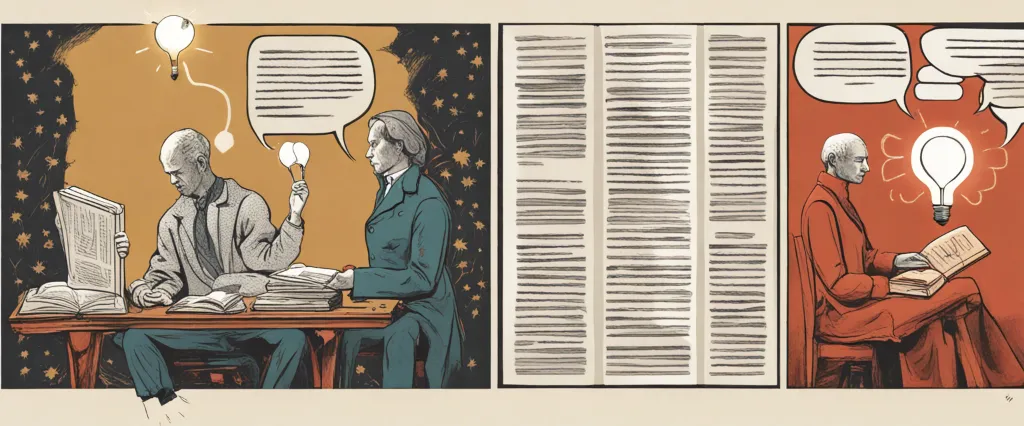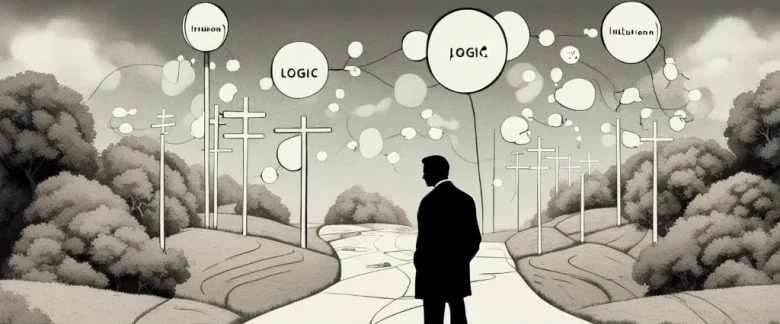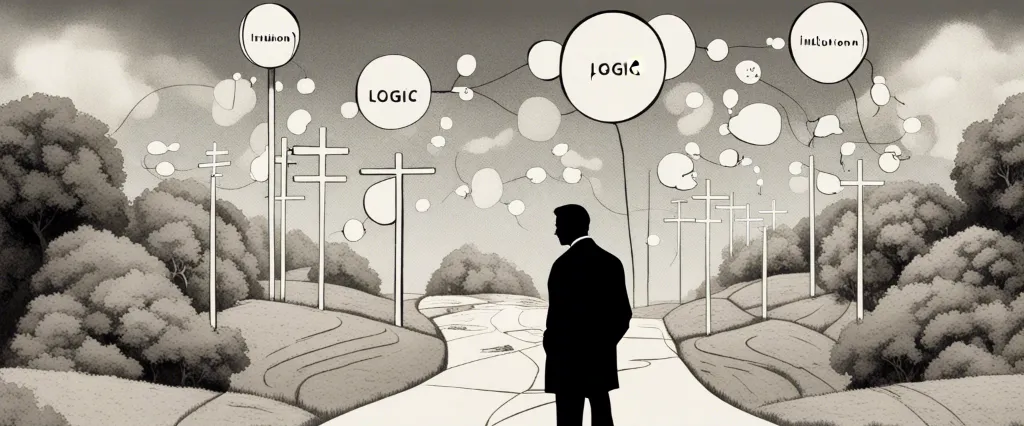InThe Decision Book by Mikael Krogerus,Mikael Krogerus presents a concise and practical guide to making better choices in life and work. This book is a valuable resource for individuals seeking to enhance their decision-making skills and maximize their potential for success. As an experienced journalist and writer, Krogerus blends academic research, real-life examples, and personal insights to offer a fresh perspective on decision-making, providing readers with a framework to navigate complex choices effectively.
Chapter 1: Insights into effective decision-making strategies
Chapter 1 of “The Decision Book” by Mikael Krogerus provides insights into effective decision-making strategies. The chapter begins by emphasizing the importance of understanding the fundamentals of decision-making in order to make better choices in life and work.
The author introduces the concept of decision-making models, which are specific frameworks that can guide individuals through the decision-making process. One of the models discussed is the Eisenhower Matrix, named after former US President Dwight D. Eisenhower. It classifies tasks into four categories: urgent and important, not urgent but important, urgent but not important, and neither urgent nor important. This model helps individuals prioritize tasks and make better decisions based on their level of urgency and importance.
Furthermore, the chapter introduces the Pareto Principle or the 80/20 rule, which states that roughly 80% of the results come from 20% of the causes. This principle helps individuals focus on the most influential factors and prioritize them accordingly.
Additionally, the chapter emphasizes the importance of considering opportunity costs when making decisions. Opportunity cost refers to the potential benefits an individual might have gained from an alternative decision or action that was not chosen. Taking into account opportunity costs can lead to more effective decision-making by considering the potential gains or losses associated with different options.
Overall, Chapter 1 of “The Decision Book” provides fundamental insights and models that aid in effective decision-making. These strategies include understanding the Eisenhower Matrix, applying the Pareto Principle, and considering opportunity costs, all of which contribute to making more informed choices.
Chapter 2: The Decision-Making Models: Different approaches to making decisions
Chapter 2 of The Decision Book by Mikael Krogerus explores different approaches to making decisions, providing readers with guidance on choosing the right model for their decision-making process. The chapter introduces four decision-making models, namely the 2×2 matrix, the decision tree, the opportunity cost, and the six thinking hats.
The first model, the 2×2 matrix, involves categorizing decisions into four quadrants based on their urgency and importance. This model helps in prioritizing tasks and focusing on what truly matters, avoiding the trap of urgent but unimportant tasks.
The decision tree is the second model, representing a visual representation of alternative options and their respective outcomes. By following the branches of the tree, decision-makers can analyze the potential consequences of each option and choose the most favorable course of action.
The opportunity cost model encourages decision-makers to consider the potential gains that could be lost by choosing a particular option. By evaluating alternate uses of available resources and recognizing the trade-offs, individuals can make more informed and efficient decisions.
Lastly, the six thinking hats model suggests that different perspectives should be considered when making decisions. Each “hat” represents a different mode of thinking: white for facts and information, red for emotions and intuition, black for critical judgment, yellow for positivity and benefits, green for creativity and alternatives, and blue for the overall process control. By wearing each hat, decision-makers can ensure a comprehensive evaluation of the decision at hand.
In summary, Chapter 2 of The Decision Book outlines four decision-making models: the 2×2 matrix, the decision tree, the opportunity cost, and the six thinking hats. These models provide readers with various tools and frameworks to approach decision-making more effectively, depending on the specific circumstances of each decision. By understanding and applying these models, individuals can enhance their decision-making skills and improve the outcomes of their choices.
Chapter 3: The Personal Decision-Making Framework: Applying decision models to personal life
Chapter 3 of “The Decision Book” by Mikael Krogerus focuses on applying decision models to our personal lives through the Personal Decision-Making Framework. This framework helps individuals make better decisions by considering various factors and steps in the decision-making process.
The chapter begins by emphasizing the importance of identifying the problem at hand and understanding its essence. Krogerus suggests that defining the problem clearly is crucial for making effective decisions. He introduces the QUESTION decision model, which stands for “Quick, Understandable, Expert, Simple, Tactful, Intuitive, Optional, Never-ending.” This model helps individuals structure their decision-making process using these characteristics.
Next, the chapter explores the “Decision Tree” model, which is an effective tool for making complex choices. It provides a visual representation of the possible outcomes and their probabilities, helping individuals evaluate risks and make informed decisions. Krogerus advises using decision trees when faced with multiple options or uncertainties.
The chapter also delves into the “SWOT Analysis,” a tool commonly used in business strategy but applicable to personal decision-making as well. By assessing strengths, weaknesses, opportunities, and threats, individuals can identify their internal and external factors that may influence a decision. This analysis encourages a comprehensive assessment of the situation.
Additionally, Krogerus introduces the concept of “opportunity cost,” reminding individuals to consider what they will have to sacrifice by choosing a particular option. The chapter emphasizes the importance of understanding that every decision involves giving up something else – be it time, money, or opportunities – and considering this trade-off is crucial for making mindful choices.
Overall, Chapter 3 of “The Decision Book” provides individuals with practical decision models and frameworks that can be applied to personal life situations. It encourages clear problem definition, visual representation of options and outcomes, SWOT analysis, and consideration of opportunity costs to enhance personal decision-making.
Chapter 4: The Work Decision-Making Framework: Applying decision models to work situations

Chapter 4 of “The Decision Book” by Mikael Krogerus focuses on the Work Decision-Making Framework, which aims to help individuals make better decisions specifically in work-related situations.
The chapter begins by emphasizing the importance of having a clear and defined purpose in our work. It states that every decision should be aligned with this purpose and that understanding our priorities is crucial for effective decision-making.
Krogerus introduces the Eisenhower Matrix, a decision model that categorizes tasks into four quadrants based on their importance and urgency. This model helps individuals prioritize their workload, allowing them to focus on tasks that align with their purpose and have the most impact.
The book also discusses the RICE framework, which stands for Reach, Impact, Confidence, and Effort. RICE is a decision model that provides a systematic approach to evaluating and prioritizing projects or tasks. By assigning a numerical value to each criterion, individuals can objectively assess the potential value and feasibility of various work-related decisions.
Additionally, Krogerus introduces the Cynefin framework, which emphasizes the importance of recognizing the complexity of different work situations. This model helps individuals categorize their decisions into the domains of simple, complicated, complex, or chaotic, allowing them to adapt their decision-making approach accordingly.
Lastly, the chapter addresses the concept of decision fatigue and the need for individuals to recharge their decision-making abilities. It suggests implementing strategies such as automation, delegation, and time management to minimize decision-making fatigue and improve overall productivity.
Overall, Chapter 4 provides valuable decision models and frameworks specifically tailored for work-related situations. It emphasizes aligning decisions with one’s purpose, prioritization techniques, objective evaluation methods, understanding complexity, and managing decision fatigue to make more impactful and effective decisions in the workplace.
Chapter 5: The Team Decision-Making Framework: Collaborative decision-making techniques
Chapter 5 of “The Decision Book” by Mikael Krogerus focuses on the team decision-making framework, which includes various collaborative techniques that can be used to make effective decisions within a group setting. The chapter outlines six techniques, namely consultation, advice process, voting, consensus, delegation, and hierarchy.
The first technique, consultation, involves the leader making the final decision after actively seeking input from the team members. This approach fosters communication and collaboration but ultimately grants the leader the authority to make the final call. The second technique, advice process, is built on the principle that decisions should be made by those who have the most expertise in the matter at hand. It encourages individuals with relevant knowledge or experience to make autonomous decisions within their field.
Voting, the third technique, is a common method where each member of the team gets an equal vote, and the decision is made based on majority rule. Moving forward, consensus is another collaborative technique wherein the group aims to find a solution that satisfies everyone. This method requires open communication, active listening, and compromise to reach an agreement that satisfies all team members.
Delegation is the fifth technique discussed, which involves empowering individuals within the team to make decisions independently. This technique is particularly efficient when a team has members with specific expertise in various areas. Finally, hierarchy is mentioned as a technique where decisions are made by a higher-ranking member or leader without consulting the team. This approach can be effective in situations when quick decisions need to be made or when there is a clear chain of command.
In conclusion, this chapter provides a comprehensive overview of different collaborative decision-making techniques that can be used within a team setting. Each technique has its own advantages and considerations, and the appropriate approach may vary depending on factors such as time constraints, expertise, and the level of consensus required.
Chapter 6: The Decision-Making Biases: Understanding common biases that affect decisions
Chapter 6 of “The Decision Book” by Mikael Krogerus focuses on the decision-making biases that commonly influence our decision-making processes. The chapter highlights the importance of being aware of these biases to enhance our decision-making abilities.
The chapter starts by explaining the concept of confirmation bias, which refers to our tendency to seek information that confirms our preconceived beliefs or preferences while ignoring or dismissing contradictory evidence. This bias can limit our ability to objectively assess different options and hinder us from making optimal decisions.
Another bias discussed in the chapter is overconfidence bias, which occurs when we overestimate our abilities and tend to be overly optimistic about the outcome of our decisions. This bias can lead to unwarranted risks and poor decision-making.
Availability bias is another common bias discussed. It involves our tendency to rely on readily available information when making decisions, even if it may not represent the full range of possibilities. This bias often leads to overlooking important but less accessible information.
The anchoring bias is also addressed in this chapter. It occurs when we give disproportionately higher weight to the first piece of information we receive, which can skew our assessment of subsequent information.
Lastly, the chapter covers the sunk cost fallacy. This bias refers to our tendency to continue investing time, resources, or effort into a past decision that has proven unfruitful, simply because we have already invested in it. This bias can blind us from considering alternative courses of action that may be more beneficial.
Overall, this chapter emphasizes the significance of recognizing and understanding these decision-making biases to make better-informed choices. By being aware of these biases, individuals can challenge their own thinking patterns and strive towards more effective decision-making.
Chapter 7: The Decision-Making Tools: Practical tools for improving decision-making
Chapter 7 of “The Decision Book” by Mikael Krogerus is titled “The Decision-Making Tools: Practical tools for improving decision-making.” In this chapter, the author introduces various decision-making tools that can be utilized to enhance the decision-making process.
The first tool discussed is Cost-Benefit Analysis. This involves weighing the potential benefits against the costs associated with a decision. By quantifying these factors, one can make a more informed decision based on the overall value.
The second tool is Decision Trees. Decision Trees are a graphical representation of a decision-making process that visually displays different decision paths and their possible outcomes. This tool helps to identify the best course of action by considering various scenarios and their probabilities.
Next, the author introduces the Pugh Matrix, a tool for evaluating options against a predetermined set of criteria. By assigning scores to each option, one can objectively compare and select the most suitable choice.
The fourth tool presented is Grid Analysis. Grid Analysis involves prioritizing various decision factors using a matrix. By assigning weights to each factor, decision-makers can evaluate choices objectively and identify the best option.
Additionally, the Eisenhower Matrix is introduced as a tool for prioritizing tasks. This matrix categorizes tasks into four quadrants based on their urgency and importance, enabling individuals to manage their time effectively.
The final tool discussed is the SWOT Analysis, which stands for Strengths, Weaknesses, Opportunities, and Threats. This analysis helps in understanding and evaluating the internal and external factors influencing a decision. By identifying these factors, one can determine strategies to maximize strengths, minimize weaknesses, capitalize on opportunities, and mitigate threats.
In conclusion, Chapter 7 of “The Decision Book” presents several practical decision-making tools. These tools provide individuals with a structured approach to evaluate options, assess risks, prioritize tasks, and generate a more informed decision-making process.

Chapter 8: Conclusion: Encouragement to apply newfound decision-making skills in life
Chapter 8 of “The Decision Book” by Mikael Krogerus, titled “Conclusion: Encouragement to apply newfound decision-making skills in life,” provides a summary and a call to action for readers to apply the decision-making tools and strategies they have learned throughout the book in their lives.
The chapter begins by emphasizing the importance of decision-making and how it permeates every aspect of our lives. It emphasizes that making decisions is not merely an intellectual exercise, but a skill that can be learned and improved upon.
Krogerus highlights the various decision-making models and concepts discussed in previous chapters, such as the Eisenhower Matrix, the Pareto Principle, and the OODA Loop, and their applicability in different scenarios. The author emphasizes that these tools are not meant to provide definite answers or guarantee success but rather guide individuals to make more informed choices.
Furthermore, Krogerus emphasizes the significance of considering the long-term consequences of decisions and the potential impact on oneself and others. He encourages readers to reflect on their personal values and goals while making decisions to ensure alignment with their true aspirations.
The chapter concludes by reminding readers that decision-making is a lifelong journey that requires patience, practice, and flexibility. It encourages readers to embrace a growth mindset and acknowledges that making mistakes is a natural part of the process. Additionally, the author suggests seeking feedback from others and continuously learning from the decisions made to become better decision-makers.
In essence, Chapter 8 concludes “The Decision Book” by inspiring readers to apply the acquired decision-making tools and strategies in their daily lives, fostering a more deliberate and thoughtful approach to decision-making.
After Reading
In conclusion, “The Decision Book” by Mikael Krogerus provides a succinct and practical guide to decision-making. Through its concise and accessible format, the book offers readers a range of decision-making models and frameworks, covering various aspects such as problem-solving, prioritization, and creativity. Krogerus simplifies complex concepts and presents them in an easily understandable manner, ensuring that readers can apply these tools to their own decision-making processes. Moreover, the book offers a multitude of real-life examples and case studies that further enhance its applicability. Overall, “The Decision Book” serves as an invaluable resource for anyone seeking to improve their decision-making skills and overcome the challenges of making choices in both personal and professional domains.
1. Thinking, Fast and Slow” by Daniel Kahneman – In this thought-provoking book, Kahneman delves into the two systems of thinking that drive our decision-making processes and explores the biases that often lead us astray.
2. Nudge: Improving Decisions About Health, Wealth, and Happiness” by Richard H. Thaler and Cass R. Sunstein – Thaler and Sunstein build on behavioral economics principles to showcase how small, subtle “nudges” can have a profound impact on our choices, helping us make better decisions in various aspects of our lives.
3. Predictably Irrational: The Hidden Forces That Shape Our Decisions” by Dan Ariely – Ariely, a renowned behavioral economist, uncovers the irrationalities that influence our decision-making, employing engaging experiments and anecdotes to demonstrate how our choices are often driven by factors beyond rational thinking.




